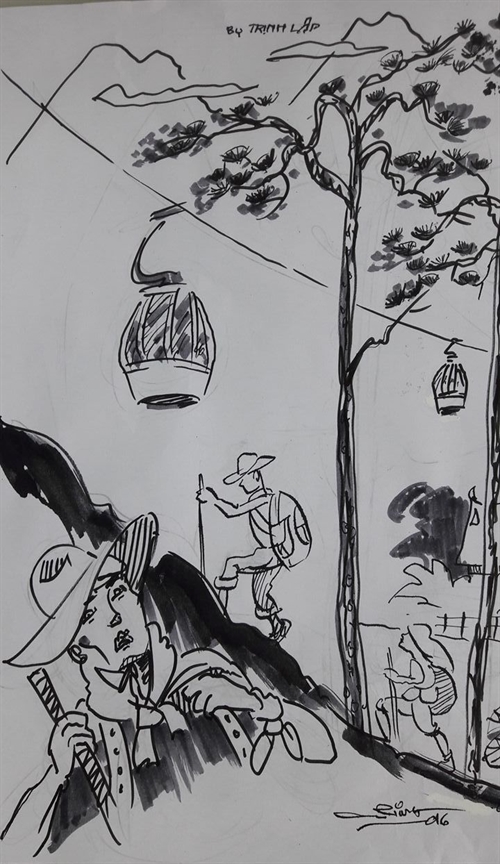 Talk Around Town
Talk Around Town

Commonly revered as the Roof of Indochina, the 3,143m Fansipan is located in the northern Vietnamese province of Lào Cai. Since the opening of the Fansipan Legend cable car system in February 2016, the peak is now within anyone's reach. But not everyone is happy.
 |
by Tú Lệ
At 3,143m, Fansipan, commonly revered as the Roof of Indochina, is located in the northern Vietnamese province of Lào Cai. I have always dreamed of visiting it. The peak is famous for not only its glorious dreamlike mountain scenery, but also for the arduous trek to get there. My dreams are now not so far from my reach thanks to the opening of the state-of-the-art Fansipan Legend cable car system in February. However, the controversy over the new cable car system came as no surprise, and created in me mixed thoughts about this special structure.
Flipping through a couple of newspapers, it was easy for me to realize the huge changes that the cable car system has brought to Sa Pa and Fansipan. With a length of 6,282m, the Fansipan Legend cable car system according to the Guinness Book of World Records has become the world’s longest three-rope cable car route. With a capacity of 30-35 passengers in each car, the whole system can carry 2,000 people an hour. The system can operate safely even during extreme weathers, so Fansipan can now welcome tourists, of all ages and health conditions, all year round.
“Standing on the summit of Indochina has been my dream for a long time, which had not been realized, due to its famously tortuous trek. Now thanks to the opening of the convenient cable car service, even my frail 78 year-old mother and my 5-year-old daughter can join me on the trip to Fansipan,” said Phạm Quốc Long, a tourist from Hà Nội, who was taking his family to visit Fansipan for the first time.
In addition to the recent inauguration of Hà Nội–Lào Cai Highway, it comes as little surprise that the Fansipan Legend cable car system has attracted significantly more tourists to Sa Pa and pushed local economic development to a higher level.
In contrast, as a hotly discussed topic on numerous online forums about travel and trekking, the construction and operation of the Fansipan Legend cable car system has faced strong opposition from different groups of trekking enthusiasts.
The system has significantly shortened the amount of time needed to reach the peak: The famously arduous trek to Fansipan used to take at least three days for a round trip - now it only takes 15 minutes for anyone to reach the peak from Mường Hoa Valley. To many people, especially for those that have taken the three-day trek, less time equals less meaning.
“Conquering Fansipan peak for many people is a life challenge. The ineffable emotion when reaching the peak and hugging the national flag after an exhausting and grueling trek was just so meaningful to me. Now with the cable cars, everything seems ordinary and boring because the whole thing takes just 15 minutes,” said Đặng Hoàng Minh, from HCM City.
For many Vietnamese young people, the Fansipan peak goes beyond being the summit of Indochina. Conquering the peak becomes a special rite of passage, a symbol of youth, determination and even nationalism.
“The most important thing during my trip to the peak was the experiences along the way, not the picture with the three-sided landmark at the peak. Travelling in the cable car, you will not have the feeling of passing through the old deep forest, feasting your own eyes on the splendid natural scenery along the way. You will not earn the priceless lessons of determination, about facing any obstacle, or realizing what you can do goes far beyond what you first thought. Travelling to Fansipan on the cable car, I guess, may disappoint you deeply because the peak itself, to be honest, is nothing remarkable,” said An Du, a young woman from HCM City who had an unforgettable trek to the summit.
The cable car system has proven a great disappoint not only to youth and adventurous trekkers, but also to environmentalists and experts on cultural conservation. The rapidly increasing number of tourists certainly has brought the hustle and bustle of a big city to Sa Pa, the cozy small town once known for its peace and quiet. The number of tourists visiting the peak has roared, leading to a boom in tourist services, which adds a lot of pressure on the conservation of nature around the peak.
“I am really concerned that Fansipan will reluctantly become a garbage dump created by the large number of irresponsible tourists. The ’leave nothing behind but your footprint’ philosophy may become a thing of the past on Fansipan," shared Trần Nam on his Facebook page.
Frankly speaking, despite being a disappointment to a fair number of adventure seekers, the Fansipan Legend cable car system has brought the famous peak closer to more people; more Vietnamese can now directly appreciate the beauty of their country. Let’s all hope that the modern cable cars come with effective management and continuously maintains the natural and cultural conservation practices in beautiful Sa Pa and Fansipan for years to come.
“Don’t be overly judgmental here. If you wish to conquer Fansipan in the traditional way, well, go for it. Get to the top on your own feet. If anyone with a health condition still wants to visit the famous peak, the cable car system is right there to serve them. It doesn’t ruin the excitement of the adventurous trekkers in any way. Don’t let your own selfishness overshadow the joy of other travellers,” cautioned Hòa Phương, a university student. VNS




